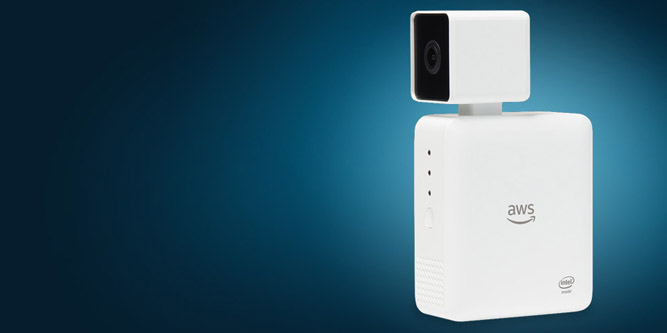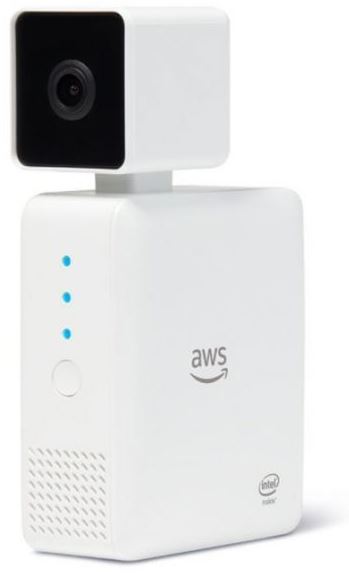Science fiction has been telling us for decades that artificial intelligence is the wave of the future. Sci-fi books and movies are filled to the brim with robots who are indistinguishable from humans in almost every way. To a point, we believe that science fiction’s view of the future has some merit, but we feel that the golden age of sci-fi was, if anything, limited in the way it viewed the future of AI.
The reality is that machines are going to be way smarter than we are. If following technology trends has taught us anything, it’s that the prospect of machines outpacing human advancement is a real possibility. Even Stephen Hawking, one of the smartest scientists in the entire universe, predicts that artificial intelligence could one day be so powerful that it will destroy civilization as we know it.
While we are smart enough to heed Hawking’s warnings (we’d be foolish not to, considering that at this point, Hawking himself is more machine than man), we tend to have a less apocalyptic view of the future of AI. Modern developments in AI and deep learning have already made ourselves easier and more productive. Technologies such as facial recognition and object detection have made our devices so much more intuitive. The ability of hardware and software to come together in an intelligent and cohesive way has slowly, but surely, altered the way we live our lives.
Deep learning is a machine learning technology that uses electronic neural networks to learn patterns and make predictions. While deep learning has been slowly making its way into consumer level products, some software developers shy away from technologies such as deep learning. It’s easy to assume that only engineers and software companies with a huge surplus of A&R resources could be at the helm of deep learning development. Up until very recently, their assumptions were absolutely correct. There just hasn’t been easy access to the necessary technology or affordable equipment. Amazon has found themselves at the helm of a new consumer technology.
First Impressions
When Amazon sees an opportunity, they take it. Amazon Web Services, aside from being Jeff Bezos’s own private cash-producing machine, has announced their AWS DeepLens, a tool for learning, training and programming with deep learning technology. While it might look like a large external webcam from 1998, the DeepLens is, in reality, the antithesis of an AOL Instant Messenger-era webcam; an instructional window into the world of AI. Amazon’s new device is a fully programmable video camera, geared towards the developer looking to stay ahead of the competition.
Education and Tutorials
The AWS DeepLens allows developers of all skill levels to start learning about deep learning. The included software provides sample projects which include hands-on examples. Even coding noobs like us were able to get a basic grasp of the concept. DeepLens provides easy access to practical applications of deep learning technology, introducing developers to the integration of deep learning into their own development projects.
Hardware
DeepLens ships with everything a developer needs to get started, including some pretty spectacular hardware. The device itself contains over 100 GFLOPs of processing power, which is enough beefiness to allow the DeepLens to process deep learning predictions using HD video. The ability to process that much deep learning computation power feels like something we shouldn’t be able to do from our homes quite yet, and yet here we are.
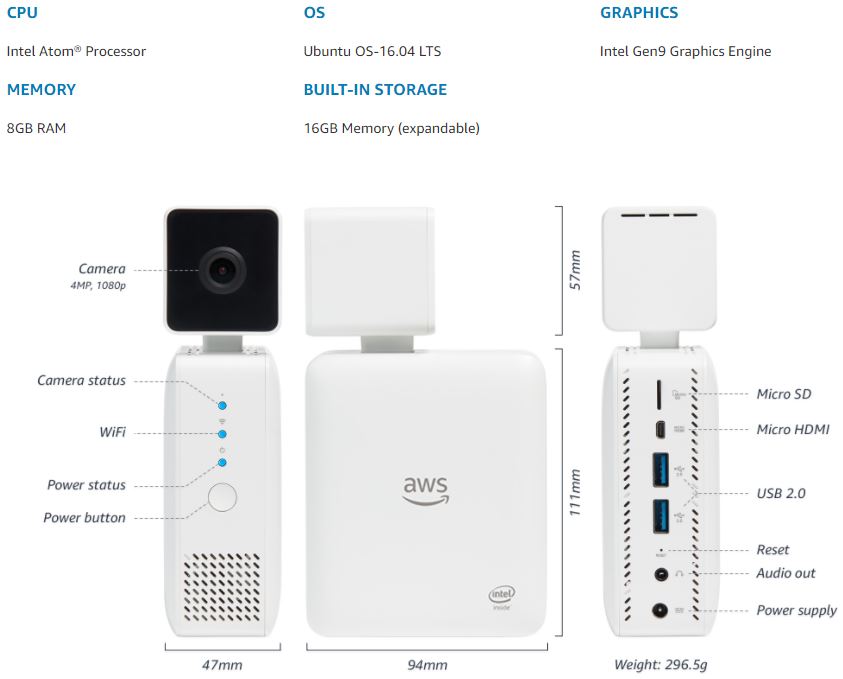
The camera is only 4 MP, but that’s all you’re going to need to get the job done; unless you’re planning on using DeepLens to print out large prints, which would make you a real weirdo. DeepLens runs on an Intel Atom processor and 8GB of RAM, all operated using Ubuntu 16.04 LTS. That’s right, folks, Linux is still kicking. Also packed inside of the DeepLens is the Intel Gen9 graphics engine and 16 GB of storage, which is expandable if you feel like you’ll need some more space.
Dimensions
True, DeepLens isn’t the smallest or most graceful of tech products, but it needs to pack all of those smarts in somewhere. Measuring in at 168 mm tall (57 mm of which is the camera) by 94mm long and 47 mm wide, it’s not going to take up a tremendous amount of room, but it’s also not going to be the most inconspicuous gadget in your collection. Though, calling this just “another gadget” is really not a fair description.
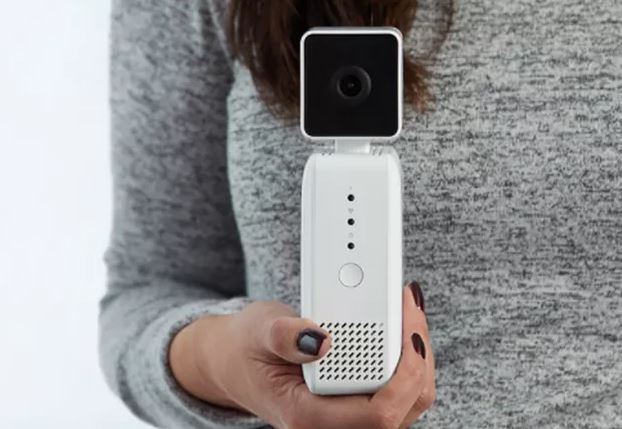
Design
On the front of the device is an indicator light for the camera status, WiFi connection and power status. The power button is pleasantly ergonomic. On the back of the device you’ll find a Micro SD slot, x2 USB 2.0 ports and a Micro HDMI port. A pinpoint reset button is there for you just in case of an emergency. You’ll also find an audio out AUX headphone jack and the power supply port.
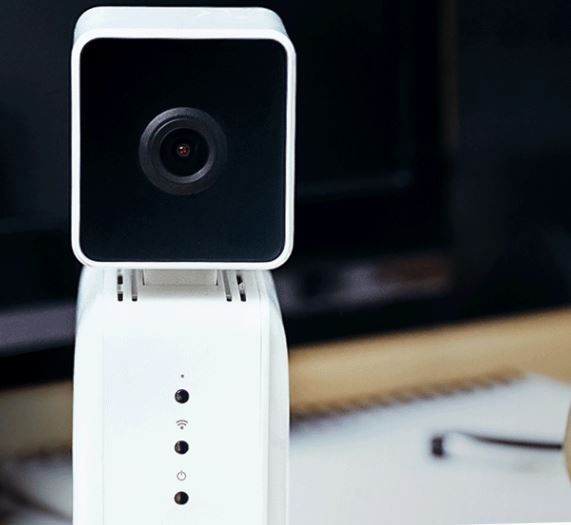
Model Testing
Getting started was super simple. Amazon claims that it takes only ten minutes to start your own deep learning project. We were too busy having fun with DeepLens to use a stop watch, but we feel like their target is spot on. The DeepLens contains a library of pre-trained models, but you can also use your own models trained using Amazon SageMaker. After your send the model over to the DeepLens, you can use the AWS management console to watch the deep learning technology in real time.

While Amazon’s SageMaker allows you to develop your own deep learning models, the DeepLens comes pre-installed with several sample projects. The great thing about the same projects is that you don’t have to put any work in to see the device in action. We’re creatures that require instant gratification.
Included in the library is a face recognition model, an object detection model; there’s one model called “Hot Dog Not Hot Dog” which does pretty much what it sounds like, it tells you if your food is a hot dog or not a hot dog. What a blessing for people who suffer from pork blindness – such a heartbreaking disorder. Another model can recognize certain activities. This model contains detection instructions for 30 different actions, including brushing your teeth, which is a perfect swan song for following hot dog detection.
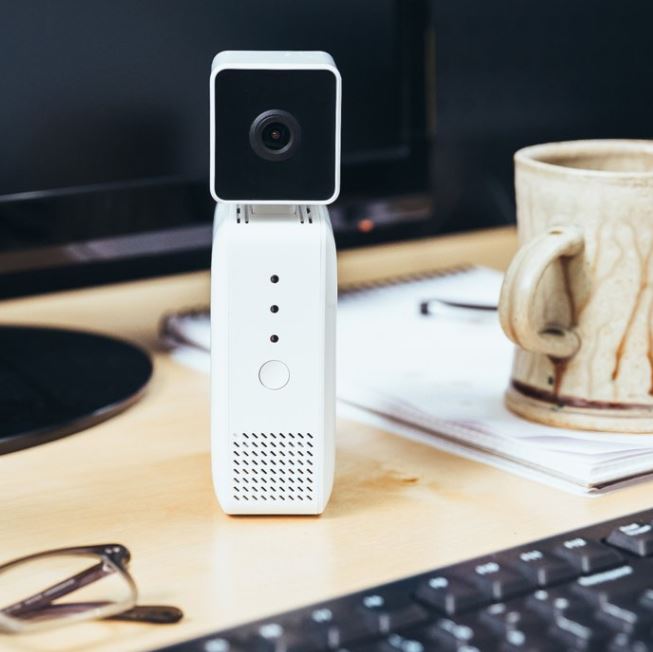
Software Integration
Anyone who uses Amazon Web Services will be happy to hear that the DeepLens integrates and syncs with many of the features you already use. The DeepLens can stream video directly back to Amazon Web Services using Amazon Kinesis Video Streams, which can then be used to play around with the analytics provided by Amazon Rekognition Video. Since we’re not Amazon Web Services pros, we didn’t use the DeepLens to its full integrated potential, but it also connects with AWS IoT, Amazon SQS, Amazon SNS, Amazon S3, Amazon DynamoDB, and if that isn’t enough, the list of compatible services continues.
Framework
Amazon Web Service developers have some flexibility when it comes to the framework they chose to build their deep learning services around. DeepLens comes preinstalled with Apache MXNet, but is compatible with TensorFlow and Caffe, as well. The DeepLens’s versatility allows developers to feel comfortable in an unfamiliar world. Once you’ve chosen your framework, it’s time to get developing. DeepLens is programmable via AWS Lambda, which is Amazon’s event-driven cloud platform. If you’ve already written code using Lambda, then the integration of the deep learning features will feel very natural. There’s a little bit of a learning curve if you’ve never used the service before, but it’s pretty easy to pick up.
Collaboration and Incentives
Amazon Web Services also offers some pretty cool collaboration features. Using Devspot, developers can share their projects with the rest of the DeepLens community. Amazon Web Services’s DeepLens Challenge takes a page out of Google’s book of tricks, offering cash rewards of over $100,000 for developers who build the best deep learning models. In addition to cash prizes, Amazon is offering three tickets to their AWS re:invent 2018 conference and three special edition custom designed DeepLens. Even if you don’t win anything, all eligible submissions will be awarded with a custom skin for your DeepLens device. If you’re looking for a little name recognition, winning an Amazon led competition could go a long way, most monetarily and through word-of-mouth traffic.
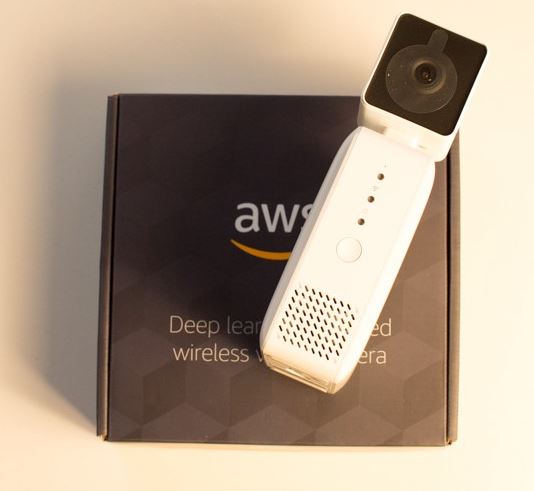
Final Thoughts
If you’re interested in delving into the world of machine learning and AI, we can’t think of a better place to begin. Amazon Web Service’s DeepLens is the perfect device for learning about how to integrate deep learning into your development projects. Using a combination of competitive incentives and tight AWS integration, Amazon has designed a product which will prove to be an indispensable tool for programmers and developers looking to up their game.
Although it plays with Amazon Web Services tools, DeepLens is versatile enough to please most developers, allowing for a variety of different frameworks. If you’ve already been using SageMaker, the DeepLens is a perfect supporting tool; it literally brings your machine learning models to life.
With the explosion of deep learning and AI products on the horizon, Amazon has set themselves up to dominate the machine learning development sector. Being a successful developer means staying ahead of the curve. If you’re going to be an innovator, the time to jump into this budding technology is right now. Once this technology blows up, it’s going to be around for a long, long time, which means that your career will be here for a long, long time. With our lack of sad lack of programming experience, our chance to become machine learning pros might be over, or at the very least, not feasible until the distant future. But for you? The sky is the limit. Someone has got to give our future overlords their big, beautiful brains. How else will Sarah Connor meet Arnold?
Meet Ry, “TechGuru,” a 36-year-old technology enthusiast with a deep passion for tech innovations. With extensive experience, he specializes in gaming hardware and software, and has expertise in gadgets, custom PCs, and audio.
Besides writing about tech and reviewing new products, he enjoys traveling, hiking, and photography. Committed to keeping up with the latest industry trends, he aims to guide readers in making informed tech decisions.

